Yeastcidin
The Mysterious Relationship of Aspergillus Oryzae and Saccharomyces Sake
The following was presented at SakeFest in Hot Springs, Arkansas in 2024. The research was based on a curiosity to how Sake yeast was being so easily identified from flowers and fruit in Japan. During my own research I was able to isolate yeast strains, but was not sure how, without DNA analysis I could create a yeast medium to isolate ONLY sake yeast. One such medium, recommended on a research paper had only one English word. “Yeastcidin”. This article summarizes my subsequent learnings. I hope this leads to us finding yeast with similar traits to that of Saccharomyces Sake that represent our localities.
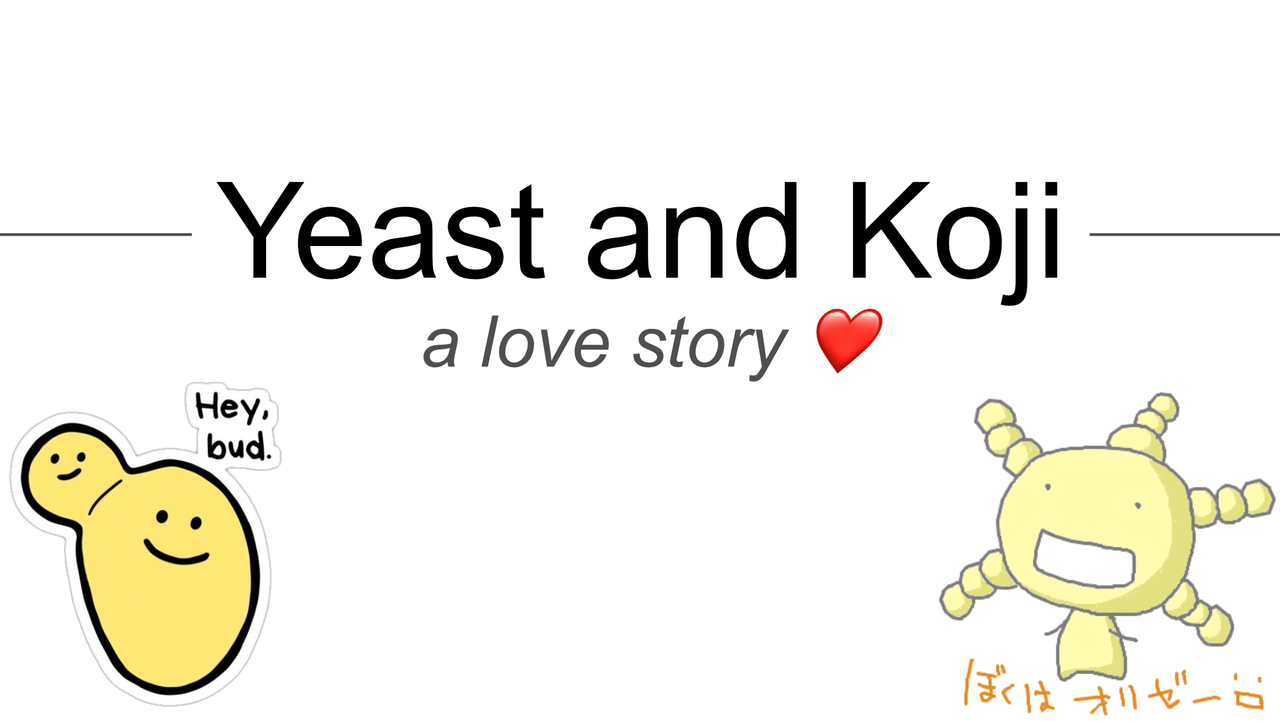
img src: https://www.mediamatic.net/en/page/87509/aspergillus-oryzae-character-from-moyashimon
Introduction
As brewers are aware, one of the key differentiators in a fermentation is yeast. The flavors and aroma potential, as well as its capabilities are determined by species.
While there are many yeast in the world, even within the Genus Saccharomyces, Sake yeast, which is Saccharomyces Cerevisiae var. Sake, has specific characteristics that beer and wine yeast simply don’t have.
To create new products with interesting profiles, choosing new yeast is often important and Sake Brewers in Japan are well aware of this. Many hybrids and mutant strains have been found, with a recent fascination of the last few decades being to identify sake yeast living on flowers, fruit, and other plants.
This often gives way to regionality and creates not only new flavors and aromas, but unique marketing stories which always draw attention from enthusiasts.
Koji Plays an equally important role in sake fermentation.
Despite not even knowing the role that yeast and koji played for thousands of years, humans managed to do amazing things with these organisms.
Sake brewers specifically were able to harness koji in ways that seemed far beyond the technology of their time. With the introduction of new scientific principles during the meiji restoration, the innovations that would follow were like pouring gasoline on a fire.
This technology revealed a critical link between koji and sake yeast and that relationship has led to the diversification of sake in Japan over the last 45 years.
Rice, Koji, Water, Yeast
It fascinates me that all of these ingredients in sake basically exist in the same place in nature. On any given rainy day in a rice field, if you could look closely at the stalks, you would find water, yeast cells, and koji spores.

It is debated how Japan learned to use these organisms, whether the knowledge of domestication was brought over by Chinese monks, or if the local farmers in Japan has independently discovered their power. Regardless, the practice of using Aspergillus Oryzae began around 1300 CE.
Initially, everything relied on the simple fact that these ingredients were sort of “co-habitating”. Even just wet rice stalks could theoretically start to ferment under certain conditions, but most of the time, success was found when cooked rice grains were mixed with some raw rice material. Realistically this wasn’t done for any kind of flavoring, but was probably just the re-use of the same bowl that the raw-rice was handled in.
Anything left overnight had the potential to start growing the koji spores (aspergillus oryzae) from the rice and as the enzymes produced from those organisms created sugar, the yeast, which were also present, would begin to ferment them into alcohol. (1,2)
This is just a simple musing, but it follows similar paths of other beverages, such as beer and wine. If you read the book “The History of the World in 6 Glasses”, you’ll note that this common discovery around the world was heavily influenced by trade as well. This is most likely how these organisms spread around the globe.
Let’s look at how these pre-historic beings become the powerful saccharomyces sake and aspergillus oryzae that they are today…
Domestication of Aspergillus
It doesn’t take much to encounter micro-organisms. They are everywhere.
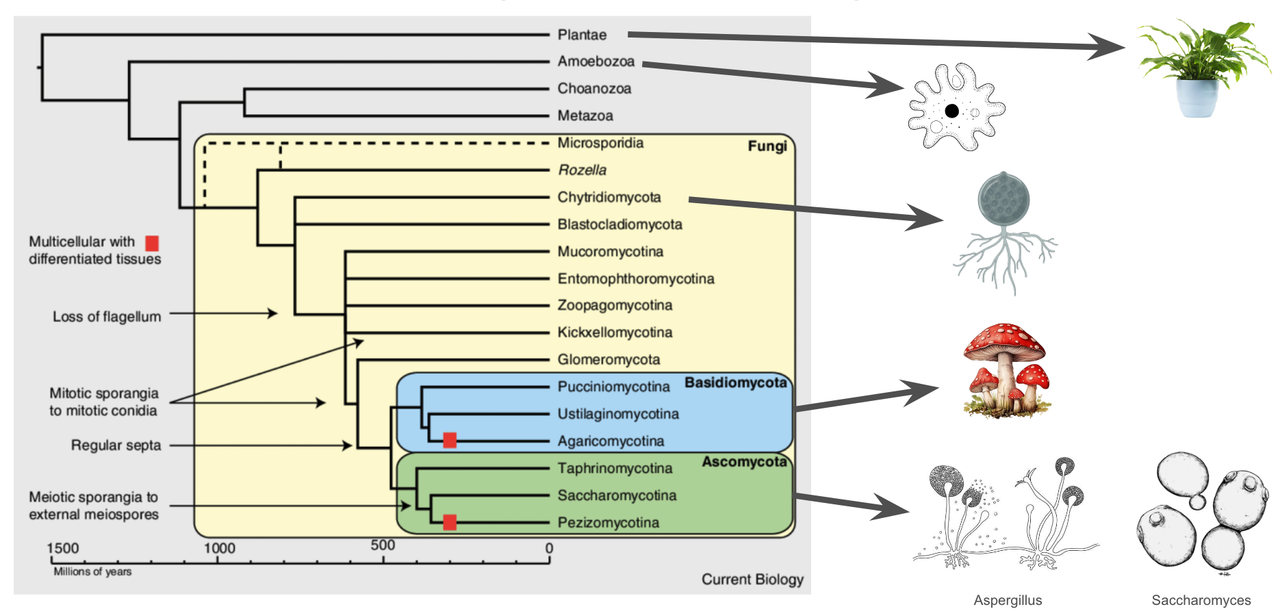
Examples of Fungi in the Phylogenetic Tree
https://www.researchgate.net/figure/The-Fungi-Phylogenetic-tree-based-on-4-showing-relationships-of-many-of-the-fungal_fig1_26855716
And as we now know, not all fungi are friendly. Some produce toxins that can even kill us or at the very least render us very sick. (3)
One of those is named Aspergillus Flavus (A. Flavus for short)

https://academic.oup.com/dnaresearch/article-pdf/26/6/465/32217926/dsz024.pdf
Divergence of A. Flavus and A. Oryzae
The Genus Aspergillus covers a broad category of micro-organisms that have very different structures, colors, behaviors, bi-products, etc.
Specifically, for the purposes of narrowing in the story line here, we’ll start farther down the evolutionary chain at Aspergillus Flavus. This particular strain is the ancestor of Aspergillus Oryzae and up until about 3000 years ago, they weren’t very different. (4)
Humans played a major role in the diversification of Aspergillus and in the time since the Chinese began using it, the phylogenetic tree has become a bit more complex:
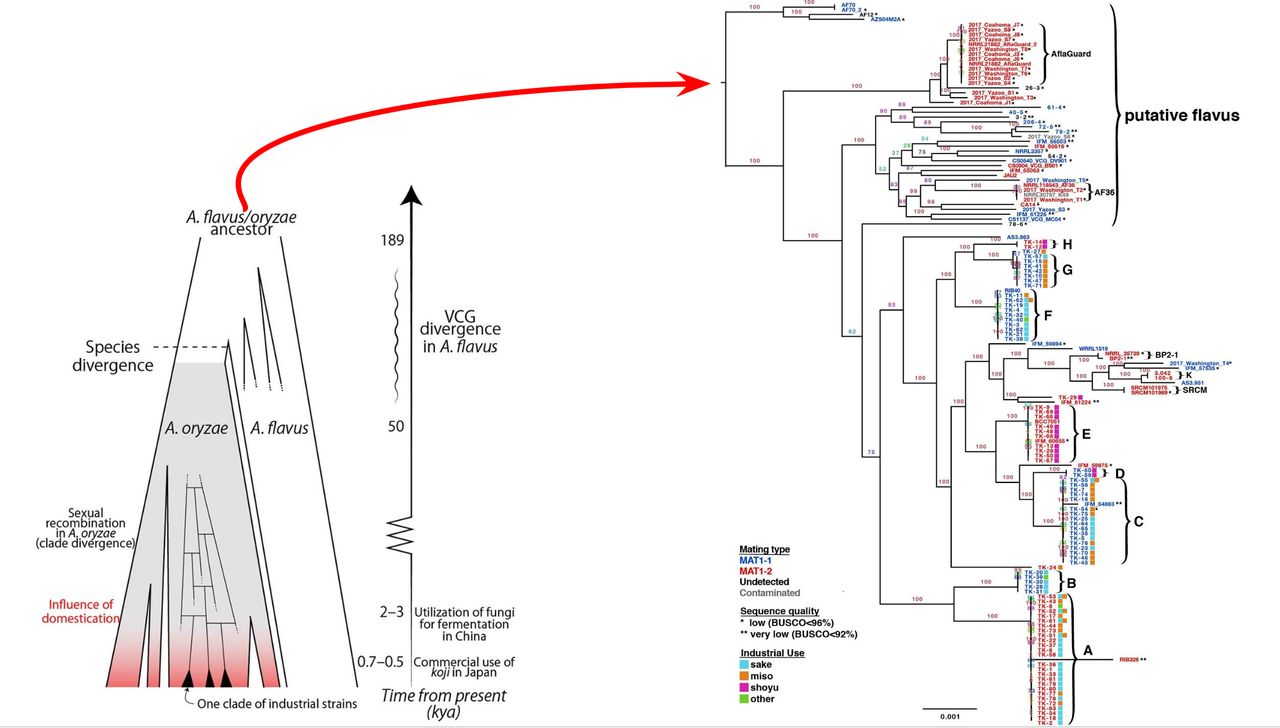
https://pubmed.ncbi.nlm.nih.gov/31755931/
Impact of Domestication on Genus Diversification
As you will note from the image below, it is almost impossible sometimes to distinguish between Aspergillus Flavus and Aspergillus Oryzae.

https://kenhdaotao.edu.vn/aspergillu-1695142759987389/
Both of these make cooked rice taste sweeter. One of them will give you cancer. (3)
Oryzae happens to be genetically coded to produce more starch-decomposing enzymes and germinates faster, making it more stable. (6)
Historians believe that the Japanese brewers might have incidentally chosen to use Aspergillus Oryzae by its brewing traits alone, and unknowingly avoided Aspergillus Flavus, which would later be identified as an aflatoxin producing strain.
Today we have hundreds of identified strains and as many of you are probably aware, just like Penicillin, which is a by-product of Aspergillus, there are many other projects underway to help us create new medicines and even natural pesticides. One of those by-products is a huge key to the connection between koji and yeast.
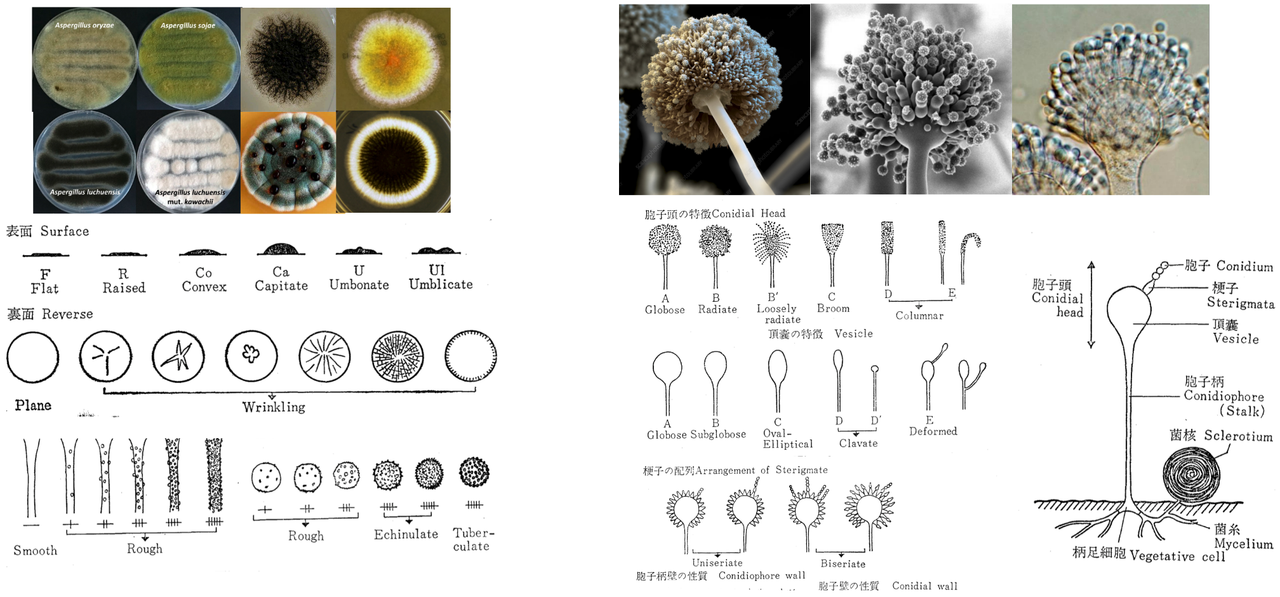
https://kenhdaotao.edu.vn/aspergillu-1695142759987389/ and (5)
Sampling of Methods for Classifying Aspergillus
Domestication of Saccharomyces
So, as brewers, we know that yeast are everywhere. Floating through the air and, hopefully, landing on fruit, flowers, or some kind of food source.
One thing I really found fascinating was that we can now say, with a good degree of certainty, that the global saccharomyces cerevisiae descended from a single strain in China, named S. Paradoxus. (1)

https://www.researchgate.net/publication/368156846_Taxonomy_Diversity_and_Typing_of_Brewing_Yeasts
Phylogenetic tree showing how all Saccharomyces Cerevisiae decended from Saccharomyces Paradoxus, seen here on the right as "SPAR". Please make note of the Dark Blue color in the "Asia" territory, indicating the "Saccharomyces Sake" genus. The farther the distance from center, the more the genus has diverged from the parent strain.
What makes this even more interesting is that Saccharomyces Sake seems to have split from the European and American species thousands of years ago and has maintained a close relationship to itself, but is a distant genetic cousin to western Wine and Beer yeasts.
While humans have been domesticating yeast since the 1600s (7), that is, reusing strains that performed well, it wasn’t exactly like we had labs set up to propagate it. For hundreds or even thousands of years, beer brewers would travel around with mash tuns that were known to make better beer than others. This is similar to the kuratsuki kobo (or yeast that inhabits sake breweries) in Japan. Now-a-days, if we do a kioke fermentation a lot of breweries will boil water inside of them to remove any bacteria or yeast before fermenting. But, in the old days, that was a huge source of the yeast that would initiate fermentation.
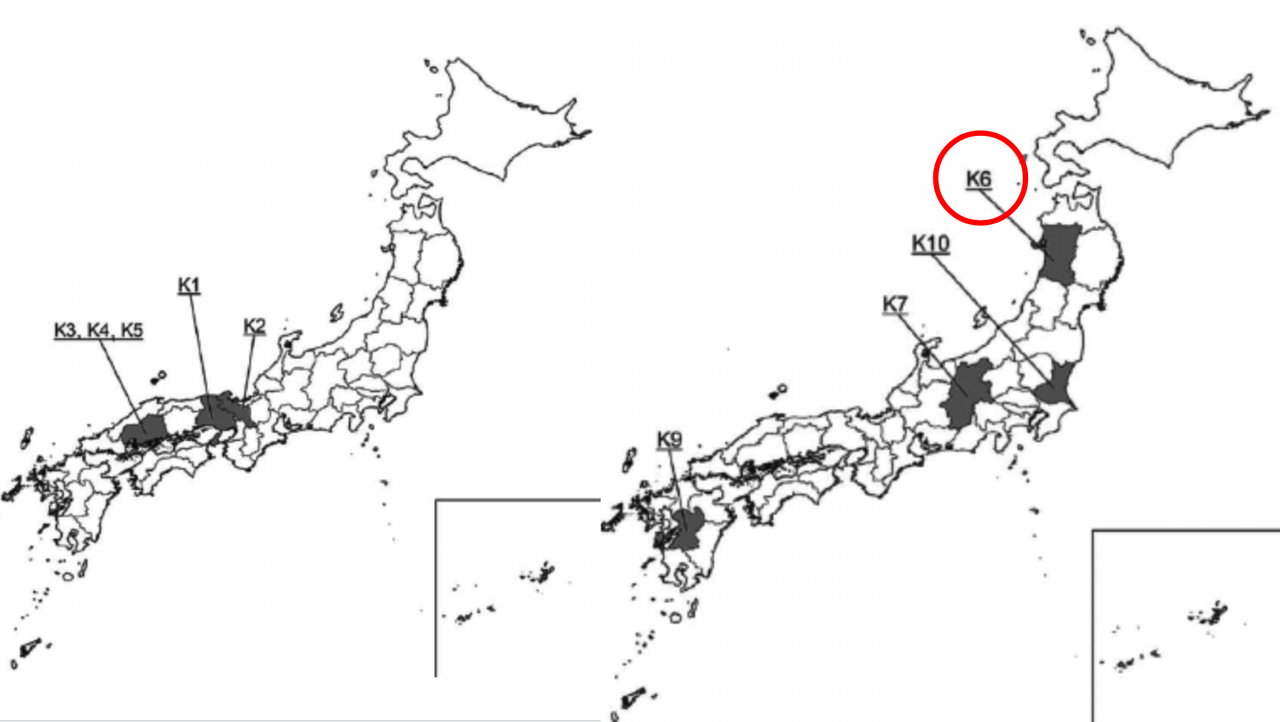
https://www.researchgate.net/publication/330282842_History_lineage_and_phenotypic_differentiation_of_sake_yeast
Geographical Discovery of Kyokyai Yeast 1-10
In 1985 … Dr. Yabe identified the first “Saccharomyces Sake” on rice straw, finally explaining the origin of yeast in the ferment. (8)
In 1906, Teizo Takahashi, a researcher at the brand new NRIB (1904), collected kuratsuki from breweries all over Japan and isolated 62 yeast strains. (9)
One strain from Sakura Masamune “櫻正宗”, performed very well and became we know to be Kyokai Yeast #1. Other strains followed, but when Aramasa yeast was isolated and named #6, all other yeasts quickly became discontinued.
This was due to its ability to perform well at low temperatures, notably improving the quality of the fermentation and allowing for consistent fermentation even in the deep, snowy regions.
It essentially changed the geography of sake production in Japan and allowed regions like Tohoku to produce sake equivalent to that of the traditionally famous areas like Nada. (10)
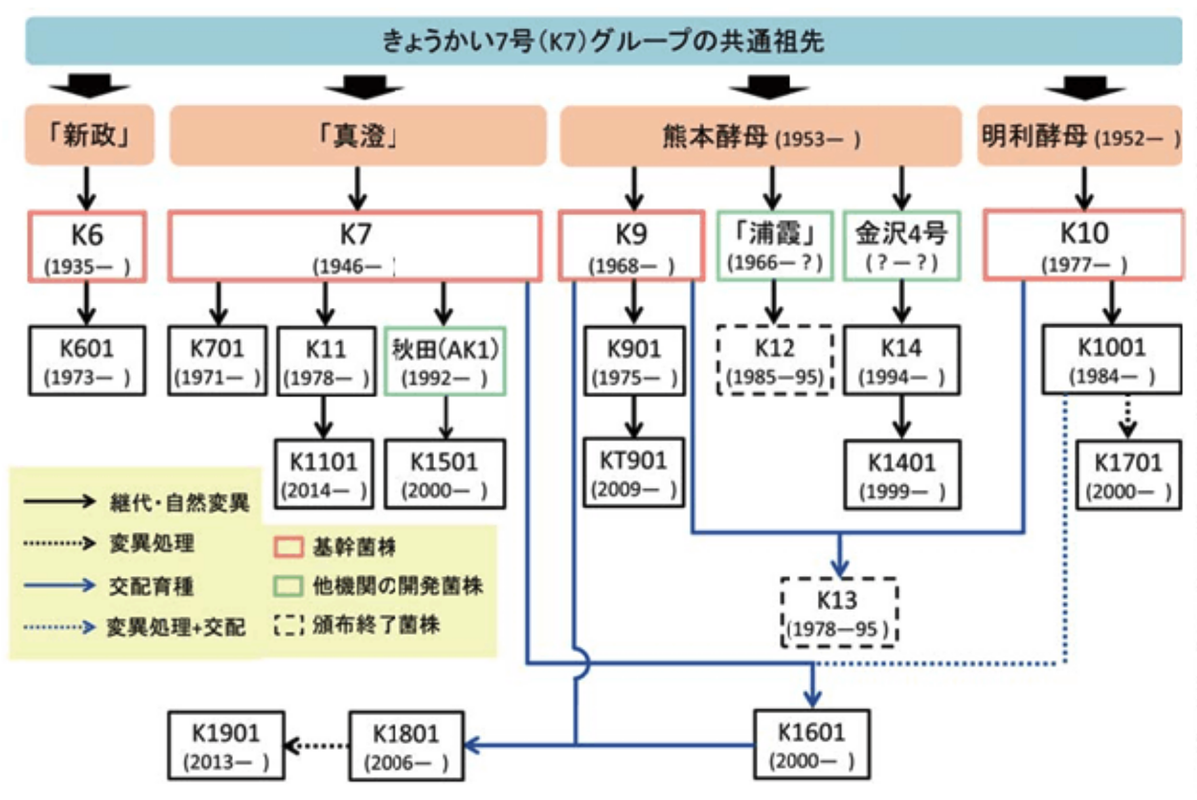
https://www.researchgate.net/publication/330282842_History_lineage_and_phenotypic_differentiation_of_sake_yeast
Masumi Yeast became #7 in 1946 and Kumamoto Yeast became #9 in 1953 and has remained the powerhouse of fermentations, because it could produce incredibly consistent fermentations, and even supplement the “weaker” aromatic yeasts that would follow.
The “weaker” yeasts, are an entirely different discussion for another day. These mutant strains are either a result of natural genetic mistakes, cross breeding, or intentionally generated by essentially blasting yeast with UV light, damaging their DNA, making them unable to perform certain tasks efficiently or at all. (11)
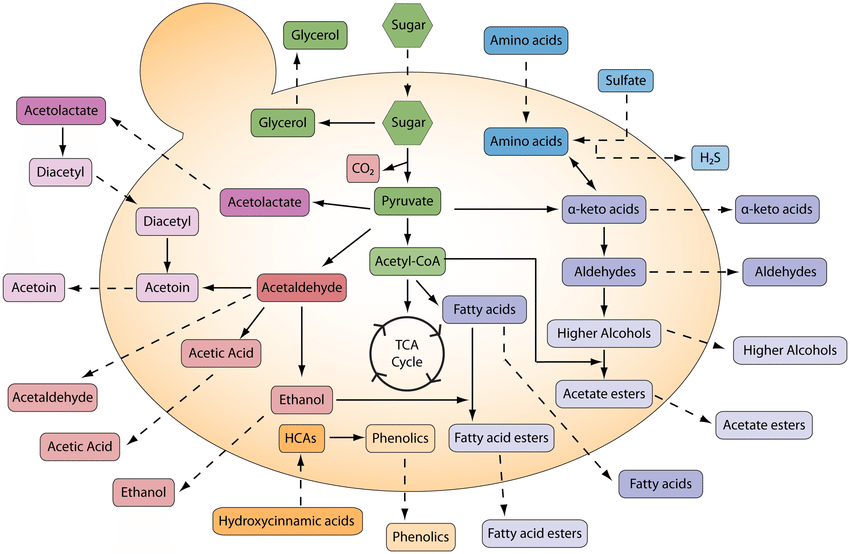
https://europepmc.org/article/PMC/5916228
This largely relates to the krebs cycle (TCA Cycle), in which various acids are produced at different points and essentially if the DNA fails to define how to properly complete one of the steps, the yeast will end up with an abundance of various products and we end up with esters, aldehydes, etc.
I haven’t personally experimented around yeast “sleep” cycles, but just like other organisms they have a circadian rhythm, shown here below and there are probably ideal times of day to stress them out vs others. Considering “stress” has such a huge impact on the production of the aforementioned by-products (esters, aldehydes, etc), this is a big question that remains unanswered for me. (12)
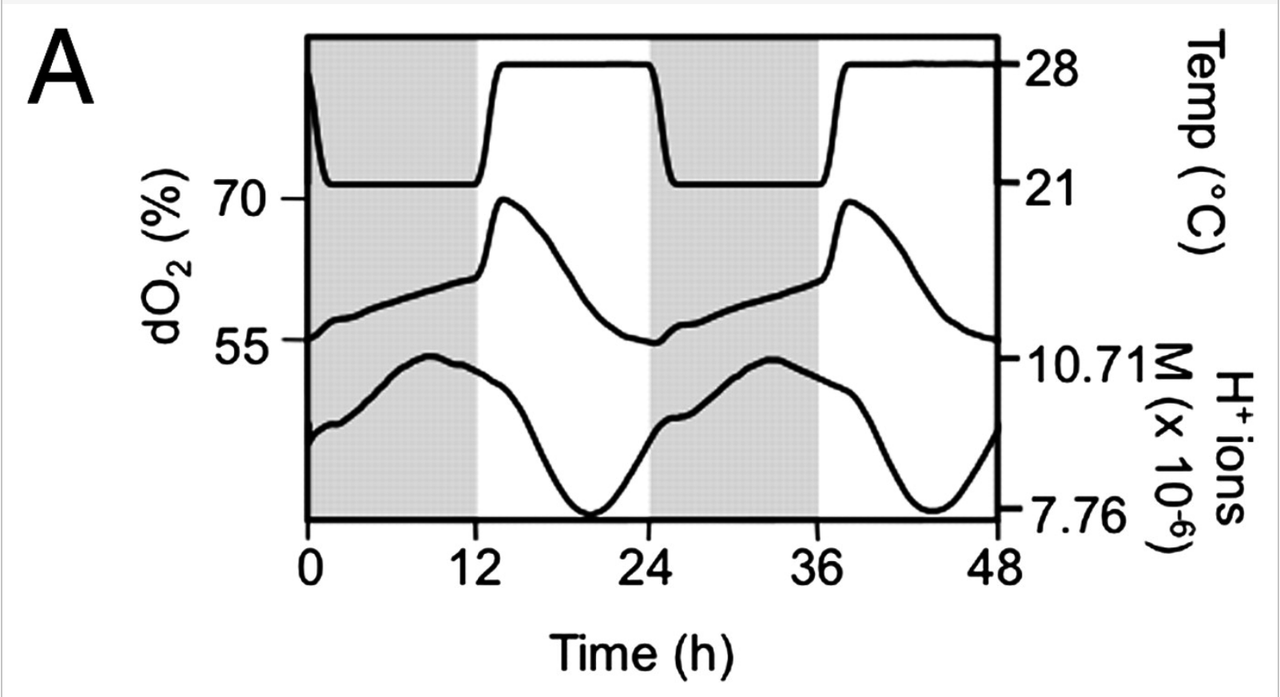
Yeast Circadian Rhythm
Now, as researchers understood this concept more, finding yeast with varying metabolisms became central to their work to diversify the market. The yeast that we know and love today are primarily a result of that effort.
Discovery of Yeastcidin
In 1971, an article revealed that when you grow certain strains of Aspergillus Oryzae in a liquid culture, it produces a substance with very particular effects.
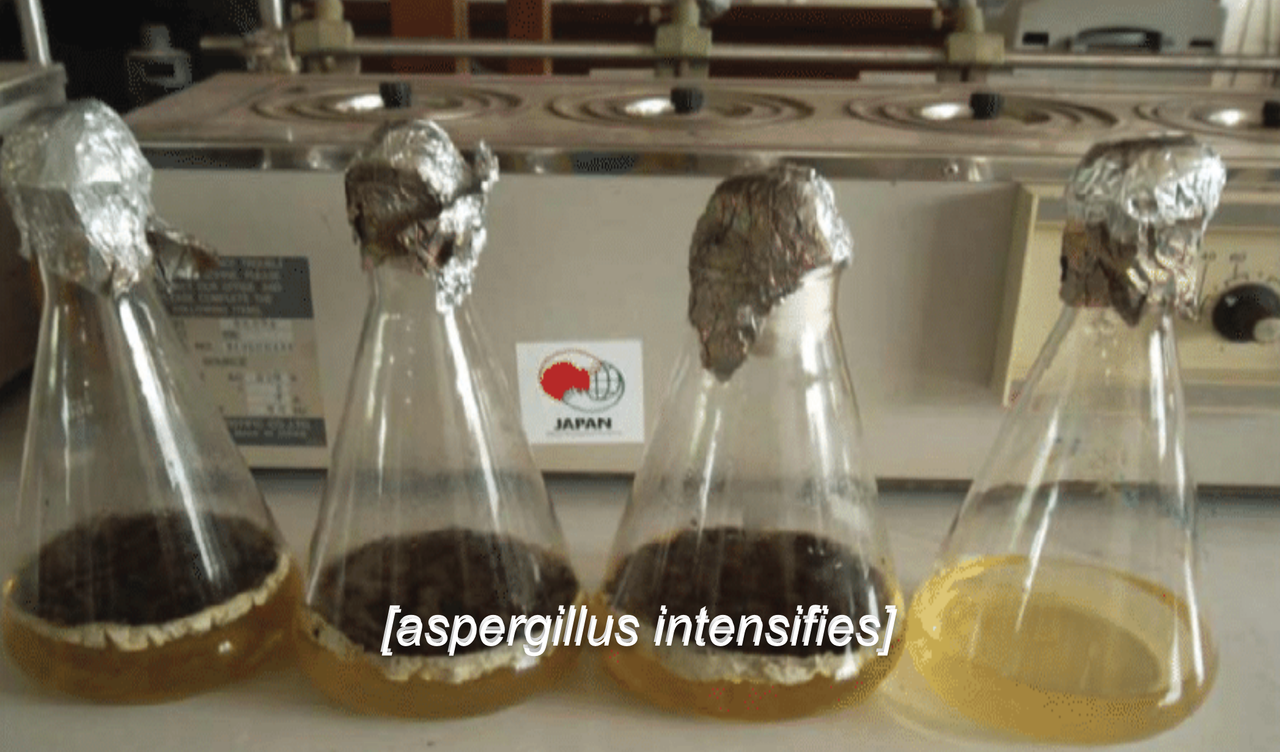
https://kenhdaotao.edu.vn/aspergillu-1695142759987389/
One of the initial Aspergillus classifications that Takahashi created in 1906, “Aspergillus Oryzae No. G” as it was named, was observed by Takeda to produce a substance he called “Yeastcidin” (13)
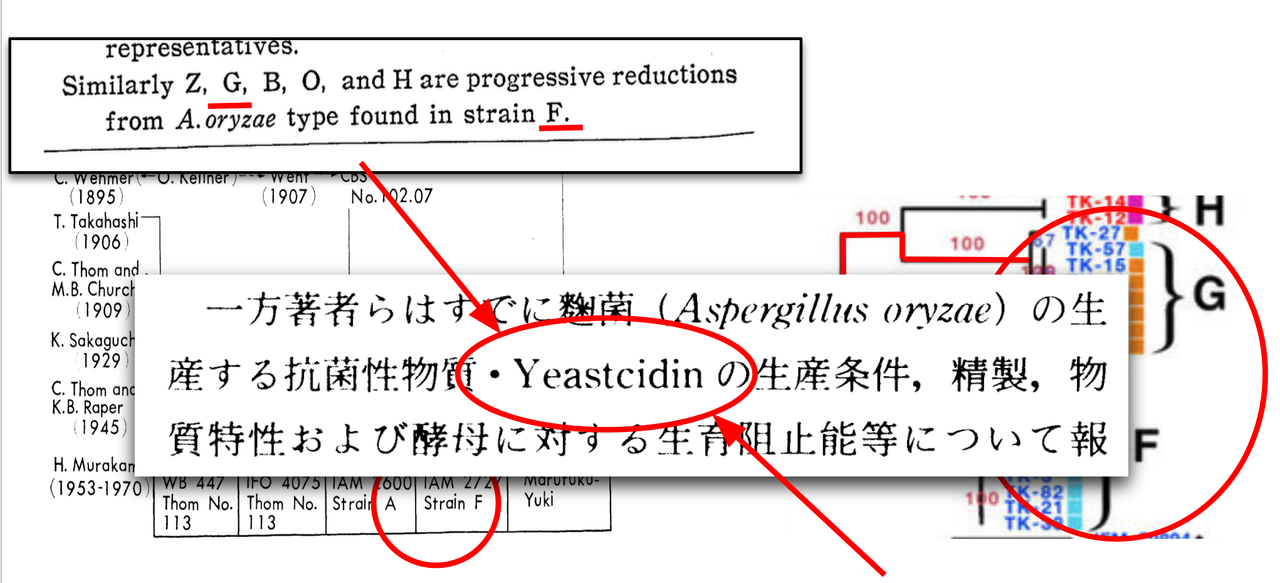
When this substance was purified and added to the growth medium, it would kill all* the yeast, (including S. cerevisiae) ….EXCEPT ….Saccharomyces Sake
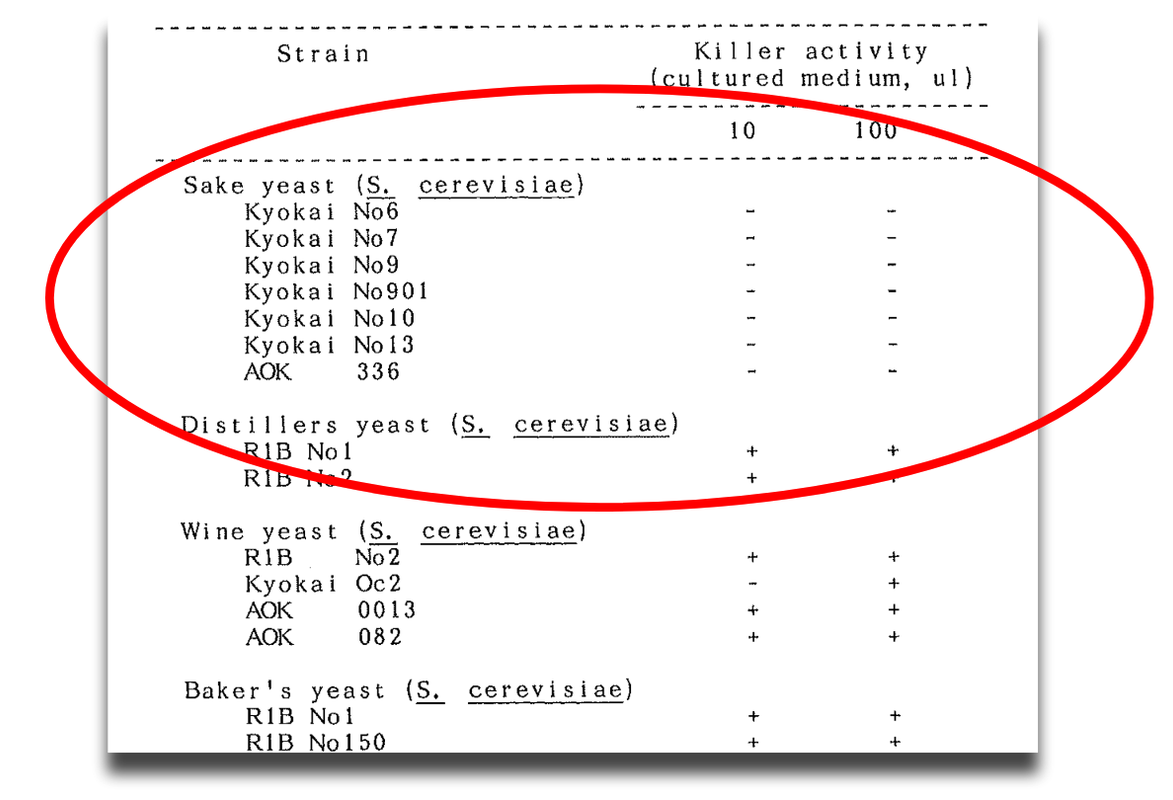
You can see the "resistance" that Sake Yeast maintain even at a high concentration of the Yeastcidin substance, while all other yeast eventually show a "+" indicating they were killed. (14)
All beer, wine, shochu, distillers yeast, etc would not grow in the presence of this substance.
So… when further combined with other known vitamin deficiency and TTC staining procedures, it was possible to easily verify the presence and isolation of new strains of Sake Yeast.
There are articles spanning the last 45 years and studies that all mention this substance and though it is still unclear what bio-mechanism is actually responsible, the capabilities are clear.
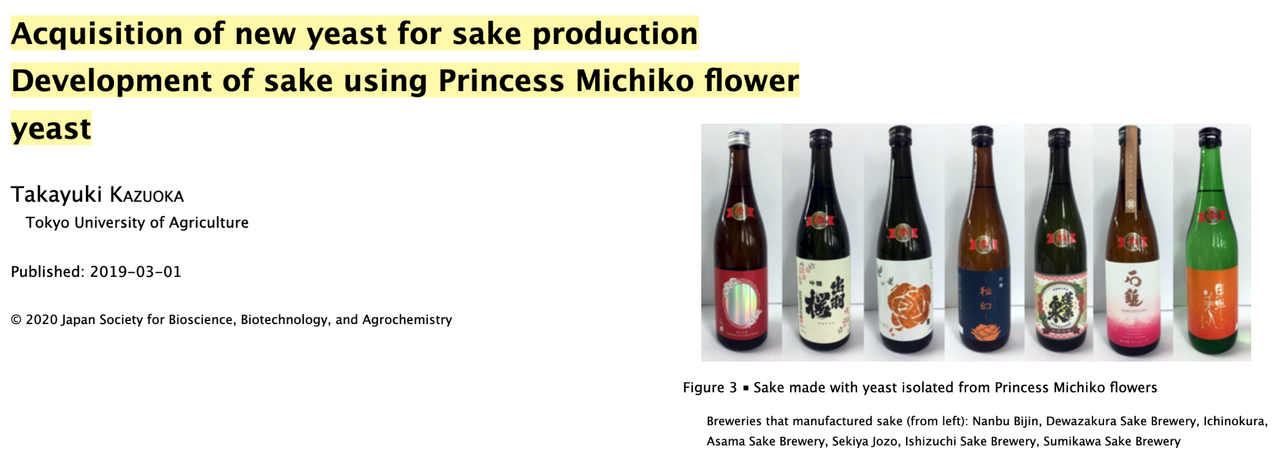
Just recently in 2019, The Princess Machiko Project (15), published its results online, identifying five new strains capable of producing alcohol comparable to Kyokai No. 9 Yeast.
So what is so Different about Sake Yeast (Saccharomyces Sake)?
Contains the Biotin Synthesis Gene (B7 vitamin)
Formation of high foam (before mutation)
Highest Alcohol Fermentation Ability (>22%)
Resistant to Yeastcidin
Sake yeast is capable of sexual reproduction, so Sake yeast can freely hybridize with beer yeast, wine yeast, baker's yeast, etc.
Only shares 80-90% of genome with S. Cerevisiae
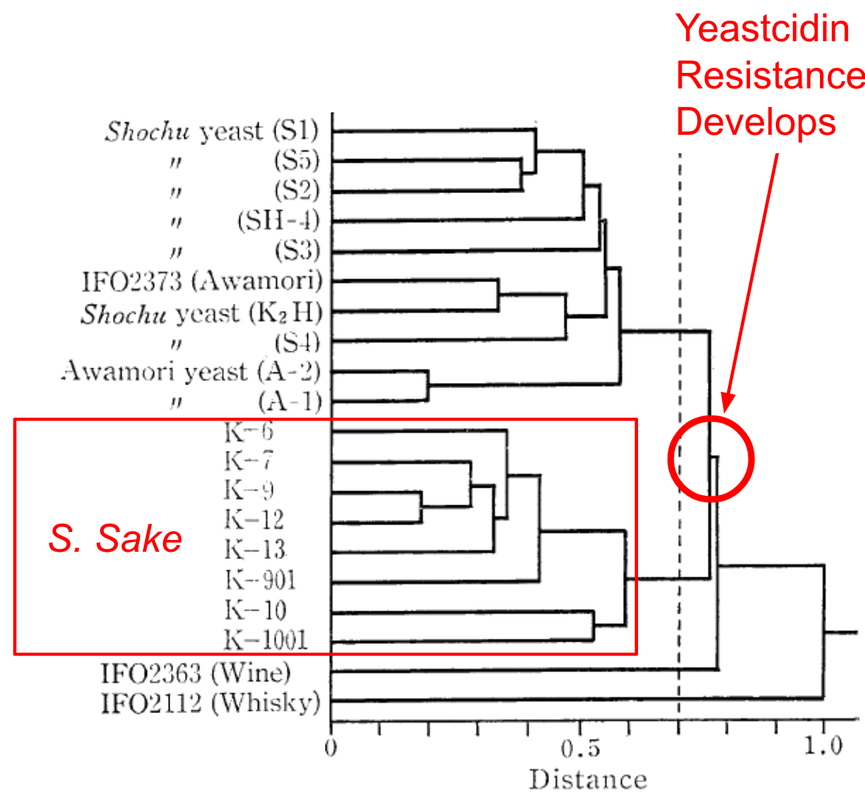
You can see on the phylogenetic tree here where Sake Yeast developed its Yeastcidin Resistance.
Shochu Yeast, which is similar in some respects is differentiated by (24):
Has Biotin Synthesis Gene
Does not form high foam
(or not easily)NO resistance to Yeastcidin
(rare cases exist)
Beer, Wine, and other Yeast
NO resistance to Yeastcidin
NO Biotin Synthesis Gene
So… What is this substance? Why does it exist? Why does it only occur when cultured in a liquid medium? Why did Aspergillus Oryzae develop a substance to protect sake yeast and does it ever occur in nature?
There is so much we don’t know…
But, when you see a flower yeast, there is almost a 99% chance that this substance was involved in its isolation.
And if you want to go hunting for sake yeast…
Making Yeastcidin
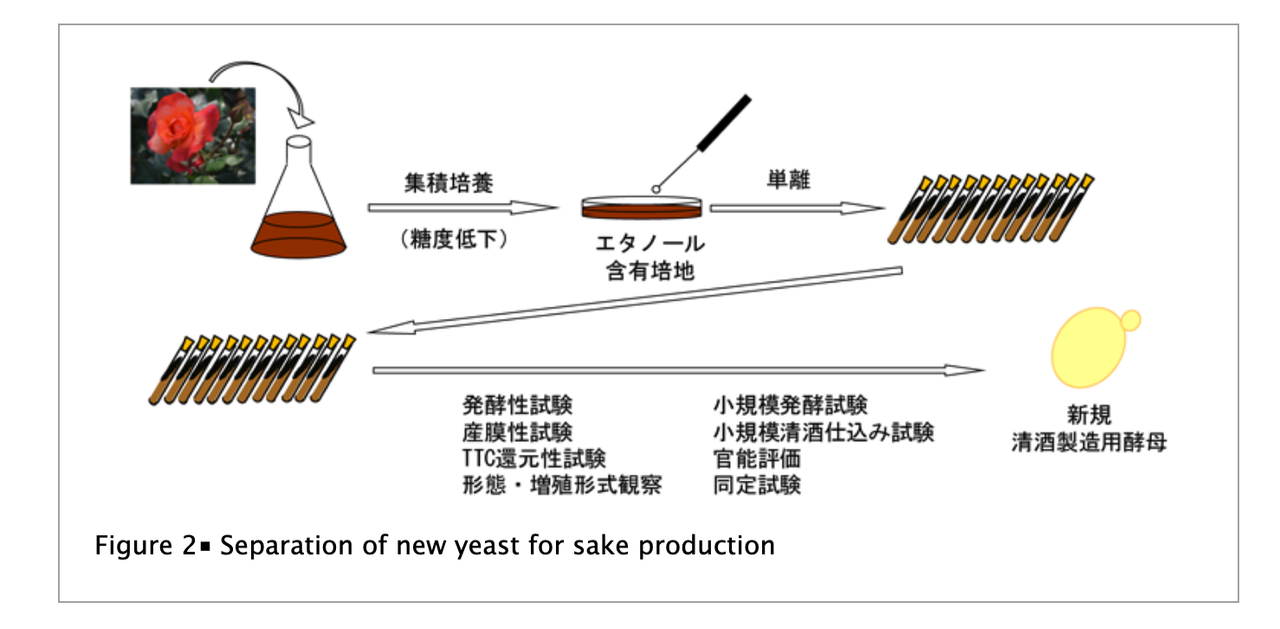
https://katosei.jsbba.or.jp/view_html.php?aid=1277
Initial capture with yeastcidin, plated with ethynol, isolate different colonies, then perform a sample fermentation to test for brewing characteristics
Here is the recipe for Yeastcidin:
Culture Aspergillus Oryzae No. G in a 10 Brix liquid medium with a ph of 5 to 6.5, at 25C for 15-20 days. I was advised that you also don’t want to agitate the flask because it will disturb the culture. (17)
While I have not found a commercial product that claims to be “A. Oryzae No. G” as often stated in publications, I do believe it is RIB1311. (18)
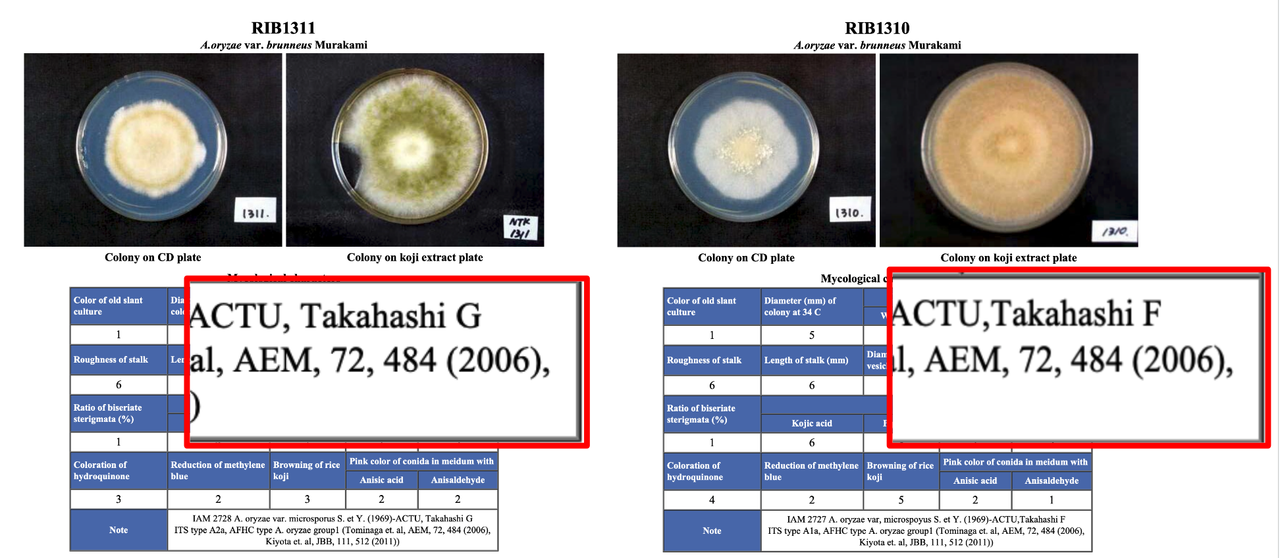
https://www.nrib.go.jp/data/asp/pdf/rib1311.pdf
As you can see… this strain profile references “Takahashi G” in the description of the strain.
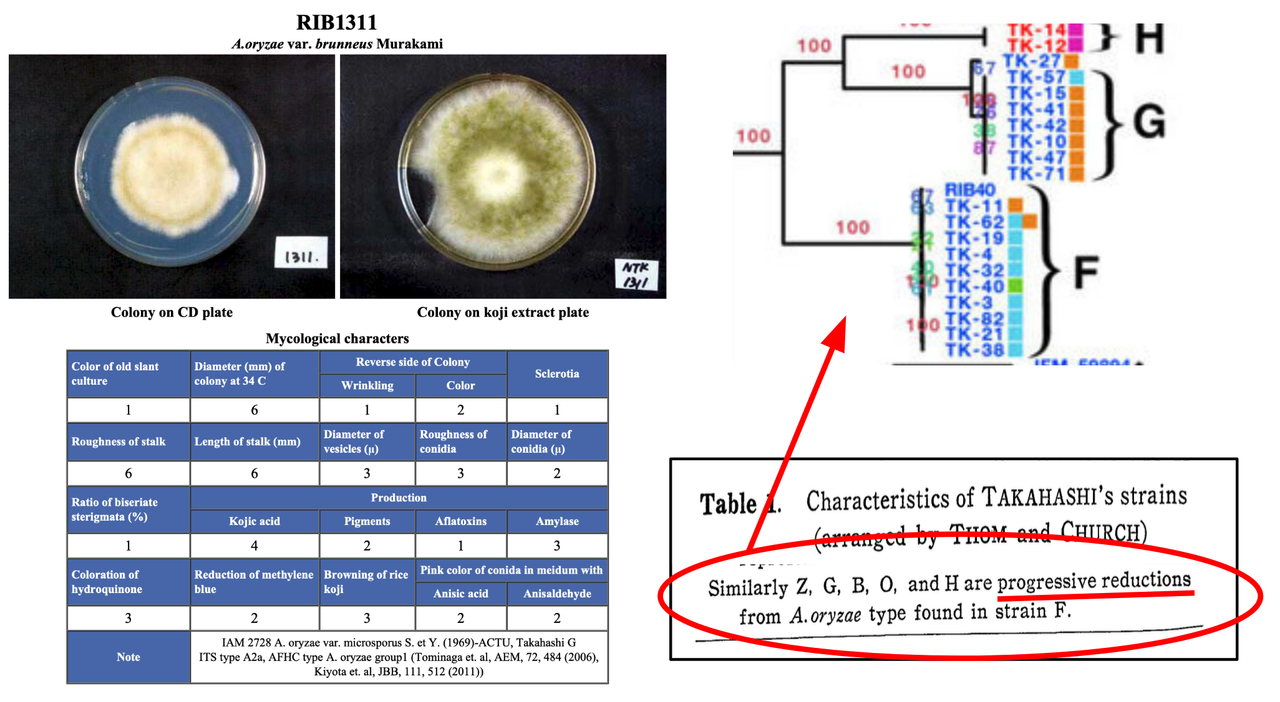
https://www.nrib.go.jp/data/asp/pdf/rib1311.pdf
There are at least 50 strains known to produce this substance and although some of them are on the not for export list (19), I think some basic trial and error should be enough to try it out. (20).
All you really need is some sake yeast and some other saccharomyces species so you can see if the substance kills all the others.
Alternative Yeast
So, this is NOT the only method for developing new sake yeast with different traits. Kyokai yeast #7 and #9 formed many new strains either through sexual reproduction or forced mutations. (21)
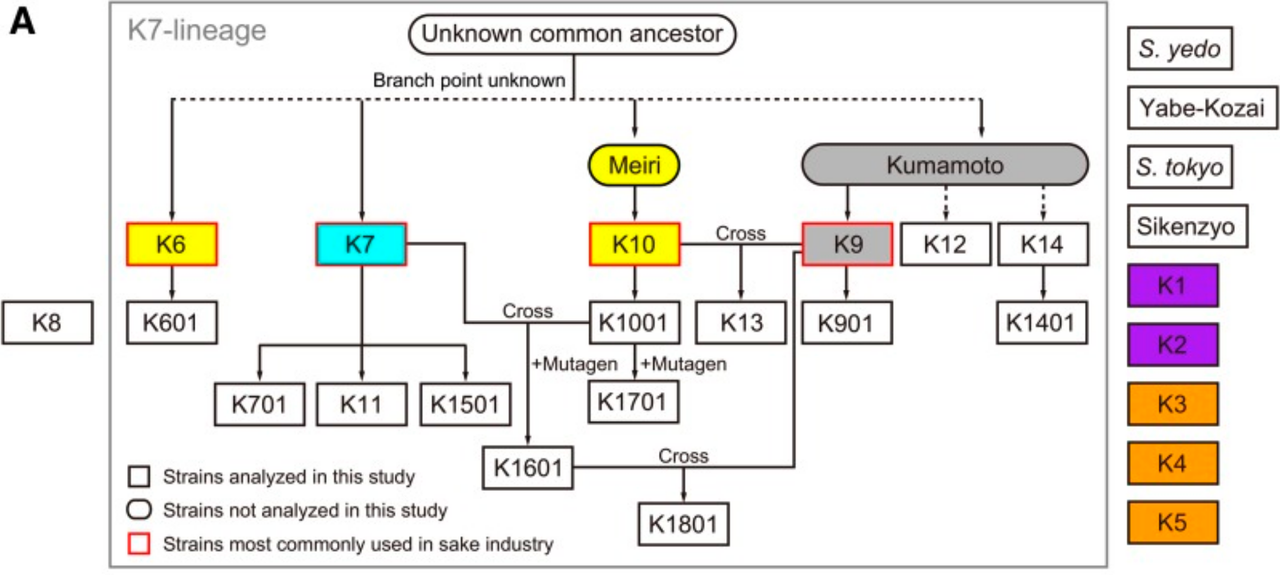
https://pubmed.ncbi.nlm.nih.gov/28642365/
Strain 1-5 and 8 are outliers, but the majority of Kyokai yeast in use today descend from 1 main ancestor. 4 main strains (6,7,9,10) have been muted and cross-bred to produce the yeast we see today.
But….just because we create a new strain, that doesn’t mean it will have beneficial features.
There are plenty of ways that it could make it worse… for instance, preventing it from making more than 4% alcohol, or it might produce substantial amounts of acetaldehyde.
Yeast Genetic Divergence

https://www.mdpi.com/2076-2607/8/6/903
You can see the migration of a parents strain (17) to Japan and North America, creating indicating a divergence in the species.
It’s entirely possible that America and Europe don’t even have native Saccharomyces Sake strains, considering how far back the species diverged. (22)
Though… I’d bet you could capture 1 or 2 strains if you start plucking flowers outside of Brooklyn Kura. (23)
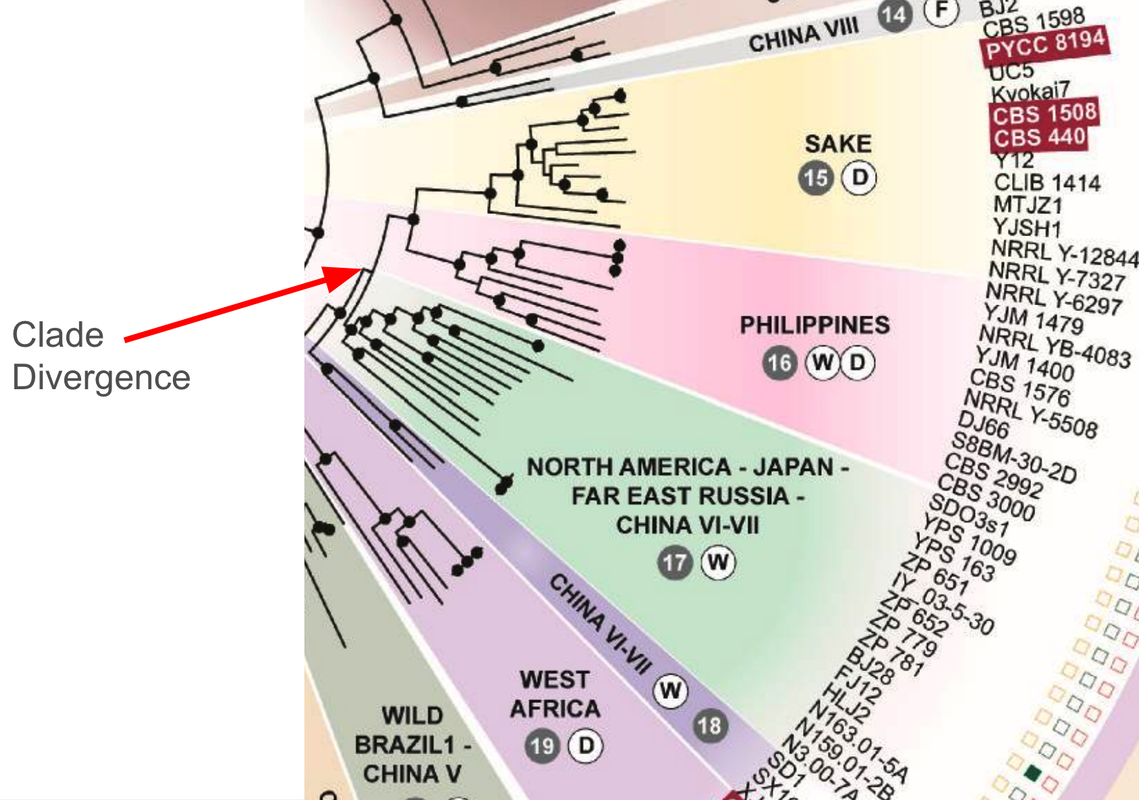
Even if Saccharomyces Sake didn’t find its way to America, there may still be enough similarities to its ancestor to develop our own regional expression and hopefully shared traits. The strains that did migrate over tend to be found on American Oak trees. Perhaps that’s a great place for us to start looking.
Conclusion
The goal of this research was to learn more about the concepts of yeast isolation and ultimately found out some fantastic connections between the history of these micro-organisms and their chemical properties.
The discovery of this substance “Yeastcidin” has no doubt had an impact on the diversification of sake yeast and therefore sake flavors and aromas.
While it remains to be seen if this will be a silver bullet to help identify our own “native” Saccharomyces Sake strains, it opens up entirely new concepts related to Koji and Yeast. I have spoken with multiple research centers that study Aspergillus and it’s by-products for potential medical and other industrial uses. None of them had heard of this substance and are very curious to learn more.
I am not a biologist. I am not a chemist. I just want to know how it all works and I find these little symbiotic connections in life to be enormously fascinating.
If you want to geek out on this with me, please reach out via our contact page and just mention this article.
Thanks for reading!
References
History, lineage and phenotypic differentiation of sake yeast
https://www.tandfonline.com/doi/pdf/10.1080/09168451.2018.1564620Koji Starter and Koji World in Japan
https://www.mdpi.com/2309-608X/7/7/569Aflatoxins: History, Significant Milestones, Recent Data on Their Toxicity and Ways to Mitigation
https://pubmed.ncbi.nlm.nih.gov/34205163/Evolution of Aspergillus oryzae before and after domestication inferred by large-scale comparative genomic analysis
https://pubmed.ncbi.nlm.nih.gov/31755931/Aspergillus oryzae group (I): Classification of Aspergillus oryzae, Hideya Murakami
”アスペルギルス・オ リゼー群(I) ―麹菌の分類―, 村上英也/国 税庁醸造試験所”
https://ndlsearch.ndl.go.jp/books/R000000016-I0038435756Do koji molds that produce Japan’s unique fermented foods exist only in this country?
https://english-meiji.net/articles/76/The Domestication of Beer Yeast
https://www.homebrewersassociation.org/how-to-brew/domestication-beer-yeast/Yeast story “酵母の話”
https://www.osake.or.jp/sake/140219.htmlMicroorganisms for sake brewing (1) - Yeast ① -
”清酒醸造の微生物(1) -酵母①-”
https://note.com/masamune_sake/n/n7864aa25b71bAbout the history and place of founding
”創業のいきさつと、創業地について”
http://www.aramasa.jp/around/Physiology, ecology and industrial applications of aroma formation in yeast.
https://europepmc.org/article/PMC/5916228A circadian clock in Saccharomyces cerevisiae
https://www.pnas.org/doi/10.1073/pnas.0907902107Masahisa Takeda, Toraji Tsukahara: 1971, Special order for Saccharomyces sake (first report) Agricultural Journal, 61, 14
”竹田正久, 塚原寅次: 1971, Saccharomyces sakeの特注(第1報) 農学集報, 61, 14”
https://agriknowledge.affrc.go.jp/RN/2010040714Characterization of Killer Glycoprotein (asperatin) produced by Aspergillus Oryzae, Sato,T., Konno, H., and kitagawa, Y, (Akita Konno Co., Ltd., Kariwano, Akita 019-21, Japan and Biotechnology Institute, Akita Prefectural College of Agr., Ogata, Akita 010-04, Japan
Acquisition of new yeast for sake production Development of sake using Princess Michiko flower yeast
”新規清酒製造用酵母の取得プリンセスミチコの花酵母を用いた清酒開発”
https://katosei.jsbba.or.jp/view_html.php?aid=1277Association No. 10 Properties of yeast ” (Hiroshi Iwata et al., Journal of Japan Brewing Association, 85, (7), 495-500 (1990))
https://www.jstage.jst.go.jp/article/jbrewsocjapan1988/85/7/85_7_495/_article/-char/ja/Annual Review of Fermentation Technology, Japan l980
”国内における発酵工業関連分野の研究・開発の動向 (昭和55年度)
https://dl.ndl.go.jp/view/prepareDownload?itemId=info%3Andljp%2Fpid%2F10544014RIB1311, A.oryzae var. brunneus Murakami
https://www.nrib.go.jp/data/asp/pdf/rib1311.pdfDistribution of Strains Controlled by the Foreign Exchange and Foreign Trade Control Law of Japan
https://jcm.brc.riken.jp/en/senryaku_e?doing_wp_cron=1708128894.4391460418701171875000Research on antibacterial substances produced by Koji molds
”こうじ菌の生産する抗菌性物質に関する研究”
https://www.jstage.jst.go.jp/article/jbrewsocjapan1915/75/9/75_9_761/_pdfBreeding sake yeast and identification of mutation patterns by synchrotron light irradiation
https://www.sciencedirect.com/science/article/abs/pii/S1389172321001158Revisiting the Taxonomic Synonyms and Populations of Saccharomyces cerevisiae—Phylogeny, Phenotypes, Ecology and Domestication
https://www.mdpi.com/2076-2607/8/6/903Flower source
https://www.brooklynkura.com/Isolation of sake yeast from an enriched culture solution using yeastcidin, an antibacterial substance produced by Aspergillus oryzae
“麹菌の生産する抗菌性物質・Yeastcidinを用いた集積培養液からの清酒酵母の分離”
https://www.jstage.jst.go.jp/article/jbrewsocjapan1988/94/12/94_12_998/_pdf
Various summarized sources on Yeastcidin:
An antibacterial ingredient unique to Aspergillus oryzae? About Yastcidin
”麹菌特有の抗菌成分?Yastcidin(イーストサイジン)について”
https://sakerecode.com/about-yastcidin-yeast-cydin-an-antibacterial-ingredient-peculiar-to-koji-mold/The story of koji mold and yeast mold
https://genbun.sakura.ne.jp/page044.htmlAbout Yeastcidin
”Yeastcidin(イーストサイジン)について”
https://genbun.sakura.ne.jp/page027.htmlI visited "Nunoya Hara Sake Brewery" which brews sake using "flower yeast
”花酵母を使ってお酒を醸している「布屋 原酒造場」を訪問してきました”
https://tarutsuna.jp/kuramoto/414/Isolation of sake yeast from an enriched culture solution using yeastcidin, an antibacterial substance produced by Aspergillus oryzae
”麹菌の生産する抗菌性物質・Yeastcidinを用いた集積培養液からの清酒酵母の分離”
https://www.jstage.jst.go.jp/article/jbrewsocjapan1988/94/12/94_12_998/_article/-char/ja/Aspergillus oryzae group (I): Classification of Aspergillus oryzae, Hideya Murakami
”アスペルギルス・オ リゼー群(I) ―麹菌の分類―, 村上英也/国 税庁醸造試験所”
https://www.jstage.jst.go.jp/article/jbrewsocjapan1915/66/7/66_7_658/_pdfResearch on antibacterial substances produced by Koji molds
”こうじ菌の生産する抗菌性物質に関する研究”
https://www.jstage.jst.go.jp/article/jbrewsocjapan1915/75/9/75_9_761/_pdfSake brewing test of yeasts isolated from flowers by using koji extract medium
”麹汁培地を用いて花から分離した酵母の清酒醸造試験”
https://www.jstage.jst.go.jp/article/jbrewsocjapan1988/100/6/100_6_454/_pdf/-char/jaSake brewing characteristics of yeasts isolated from flowers by an enrichment culture method
”花から分離した酵母の醸造特性”
https://www.jstage.jst.go.jp/article/jbrewsocjapan1988/99/10/99_10_743/_pdf/-char/jaFermentability of Sake Moromi Prepared with Shochu, Wine, Brewer's, Alcohol, or Sake strains of Saccharomyces cerevisiae
”各種醸造酵母による清酒の仕込み試験”
https://www.jstage.jst.go.jp/article/jbrewsocjapan1988/93/10/93_10_833/_pdf/-char/jaOn the Saké Yeast-Group in Saké-Mashes
”清酒もろみ中の清酒酵母群について”
https://www.jstage.jst.go.jp/article/jbrewsocjapan1915/76/5/76_5_356/_pdf/-char/jaAdvances in sake brewing microbiology
“清酒醸造微生物学の進歩”
https://www.jstage.jst.go.jp/article/jbrewsocjapan1915/79/5/79_5_335/_pdfAntibacterial composition induced by Aspergillus oryzae culture using yeast cell walls
”酵母細胞壁を用いた麹菌培養で誘導される抗菌組成物”
https://patents.google.com/patent/JPWO2018056271A1/jaIsolation of Sake Brewing Yeast and its Practical Use
”清酒製造用酵母の分離および実用化”
https://www.jstage.jst.go.jp/article/jbrewsocjapan/110/5/110_298/_pdfMold Library: Aspergillus Oryzae
https://library.bustmold.com/aspergillus/aspergillus-oryzae/CLASSIFICATION OF THE KOJI MOLD, HIDEYA MURAKAMI
https://www.jstage.jst.go.jp/article/jgam1955/17/4/17_4_281/_pdfCultivation method of Aspergillus oryzae using basic culture and use of the derived antibacterial composition
”塩基性培養による麹菌の培養方法と誘導される抗菌組成物の利用”
https://ipforce.jp/patent-jp-S-2017-43615The yeasts, a taxonomic study, 5th edition, Key to species Taxonomic characterization of national sake yeast
”The yeasts, a taxonomic study 第 5 版の Key to species による国酒酵母の分類学的特徴付け”
https://www.jsmrs.jp/journal/No36_2/No36_2_25.pdfResearch achievements in alcoholic beverages in 1981
”昭和55年度における酒類の研究業績”
https://www.jstage.jst.go.jp/article/jbrewsocjapan1915/76/4/76_4_229/_pdf/-char/jaSake brewing characteristics of yeasts isolated from flowers by an enrichment culture method
https://www.jstage.jst.go.jp/article/jbrewsocjapan1988/99/10/99_10_743/_articlePlant-seale Sake brewing with Sake type yeasts (strain ND and strain HNG) isolated from flowers by the enrichment culture method
https://www.jstage.jst.go.jp/article/jbrewsocjapan1988/95/11/95_11_837/_articleResearch on Yeastcidin, an antibacterial substance produced by Aspergillus oryzae
”麹菌の生産する抗菌性物質・Yeastcidinに関する研究”
https://dl.ndl.go.jp/view/prepareDownload?itemId=info%3Andljp%2Fpid%2F10542669Trends in research and development in fields related to the fermentation industry in Japan (1981)
“国内における発酵工業関連分野の研究・開発の 動向(昭和55年度)”
https://dl.ndl.go.jp/view/prepareDownload?itemId=info%3Andljp%2Fpid%2F10544014Brewing yeast culture conditions and TTC staining properties
“醸造用酵母の培養条件とTTC染色性”
https://www.jstage.jst.go.jp/article/jbrewsocjapan1988/94/12/94_12_1006/_article/-char/ja/Exploring new sake using flower yeast - Overview and development procedure
”花酵母で探る新しい酒~概要と開発手順~”
https://sakerecode.com/new-liquor-outline-and-development-procedure-to-explore-with-hanakobo/Breeding of yeast ~ In search of a better aroma
”酵母の育種~より良い香りを求めて~”
https://sakerecode.com/breeding-yeast-in-search-of-better-flavor/Relationship between evolution and domestication of Aspergillus oryzae
”麹菌A. oryzaeの進化と家畜化の関係”
https://www.titech.ac.jp/news/2019/045760The secret of the compatibility between rice and koji mold, the science of koji making
“麹造りを科学するお米と麹菌の相性の秘密”
https://www.gekkeikan.co.jp/RD/sake/sake03/Flower Isolated Yeast
“花分離酵母”
https://www.nodai.ac.jp/application/files/1215/5384/0582/H29.pdfCharacteristics of Yeast Isolated from an Enriched Culture Made from Koji Extract.
”麹汁培地を用いた集積培養液から分離した酵母の性質”
https://www.jstage.jst.go.jp/article/jbrewsocjapan/107/4/107_271/_pdfAbout brewed yeast
”蔵付き酵母について”
https://note.com/ryusei_sake/n/na91bcb1cfc1b

